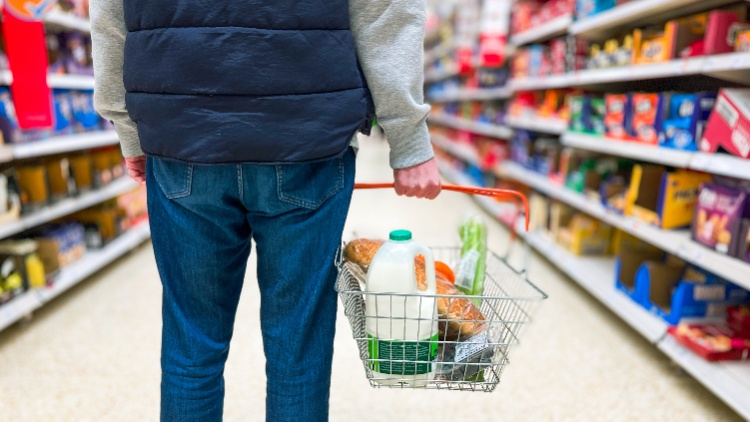The recent rise in grocery prices has prompted the Competition and Markets Authority to investigate the UK grocery sector to establish whether weak or ineffective competition between retailers has contributed to the increases.
While the CMA initially found that recent grocery price increases “do not appear to be driven at an aggregate level by weak or ineffective competition between retailers”, it also confirmed that it intends to investigate further the drivers of prices; for example, by looking at whether there is a lack of competition in other parts of the supply chain. The latest update on the investigation was published on the CMA website in July 2023.
The gap between consumer price inflation and food price inflation
Although food price inflation has started to decline (from a 45-year high of 19.1% in March 2023), food prices are expected to remain high through mid-2024. This lag in consumer food prices has raised concerns that weak competition in the food supply chain could cause food inflation to persist.
The CMA found no evidence of these concerns. It found that one contributing factor was the nature of contracts across the supply chain, where input costs only change when agreements are renegotiated, regardless of whether the market price of the commodity has fluctuated in the meantime. One example of this relates to energy costs, where fixed contracts apply but falling prices take time to be reflected in product prices.
Consumer response to rising food prices
Between 2003 and 2023, the four biggest supermarkets (Tesco, Sainsbury’s, Morrisons and Asda) and the two discounters (Lidl and Aldi) accounted for more than 80% of the UK grocery market. Their financial statements for the last financial year showed that revenues fell below the rate of inflation. The Competition and Markets Authority found no evidence to suggest that this was due to weak competition, but rather that consumer behaviour had changed.
Consumers are shopping everywhere, wherever they can, to get the best deals and buy from multiple retailers. In addition, the share of branded products sold by many retailers has declined as consumers switch to their own branded alternatives. Not only are they “trading” within ranges, they are also changing the types of products they buy, for example swapping fresh vegetables for frozen alternatives.
Consumers are more price sensitive than ever before, and are less willing to pay more for the “in-store experience,” which benefits discount retailers and increases their market share. In turn, this puts pressure on other retailers to lower their prices to maintain their market position.
But not all consumers can benefit from competition among food retailers (especially low-income households, those who shop primarily at discount stores, or those who have difficulty shopping for the best deals). Discount stores are not available to these consumers where travel is not an option (in the absence of online shopping), which prevents them from accessing lower prices. In addition, these consumers may rely more heavily on retail stores, which tend to be more expensive and stock mostly branded products.
How do retailers set prices?
The Competition and Markets Authority looked at how competition between retailers ensured that prices remained as low as possible. Retailers typically set their prices by tracking competitors’ prices and matching or undercutting them, particularly for commonly purchased food items. For some retailers, competitors’ prices were a more important factor in setting retail prices than input costs and suppliers’ prices.
Many retailers have cut prices on some essential products including milk, bread, pasta and oils. This is due to lower input costs and to maintain competitiveness in the market. Retailers have also suggested that this was to encourage customer loyalty and attract new customers, and in response to price moves by competitors.
Food retailers are planning to increase their operating margins this year. However, the current competitive environment is likely to limit the extent to which retailers can achieve higher margins without losing market share. To reduce input costs, retailers are looking for efficiencies and ways to cut overheads (self-service and optimising shifts to reduce labour costs). As input costs fall, the Competition and Markets Authority will continue to monitor the competitive landscape. However, not all costs are expected to fall. For example, food supply is a labour-intensive industry and labour costs are likely to remain the same, if not rise. Additionally, with the increased focus on sustainability and healthy eating, some regulations – such as the plastic packaging tax – have come into effect which are likely to increase costs across the food supply chain.
Retailers' relationships with their suppliers
Private label products account for about half of total sales for many retailers. Relationships between retailers and suppliers have become closer over the past two years, enabling them to work together to ensure lower prices for consumers. Larger retailers in particular have the bargaining power to ensure that the prices they pay to private label suppliers are competitive.
Branded suppliers generally operate on a higher profit margin than private label suppliers. Some branded goods within a product category are seen as the only ‘trusted’ brand, such as Heinz baked beans. Retailers have less bargaining power in these situations and therefore less ability to challenge the price charged by the supplier. The CMA has indicated that it will continue to gather evidence from suppliers to consider competition at this level of the supply chain.
Where does the CMA go from here?
The CMA plans to investigate further into other parts of the grocery supply chain to assess whether it is working effectively for consumers, and to understand pricing and competition dynamics. Given the complexity of the wider supply chain, the CMA has also identified several product categories to investigate over the coming months, including infant formula, bread, pet food, poultry, milk, mayonnaise, baked beans, chilled desserts, ready meals and lemonade.
In other news, Yorkshire brewer Timothy Taylors has announced plans to expand its brewery in Keighley, West Yorkshire, as part of a £9m investment programme.


